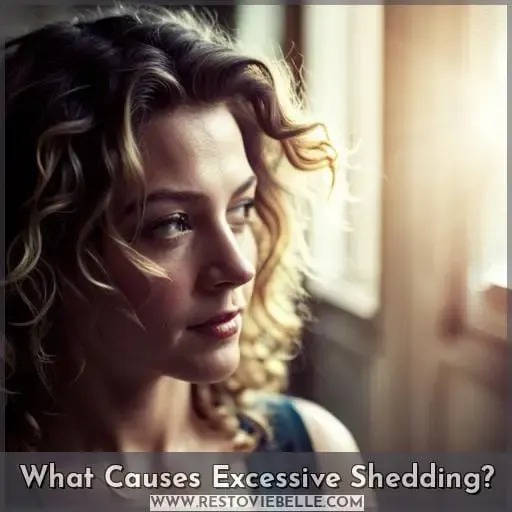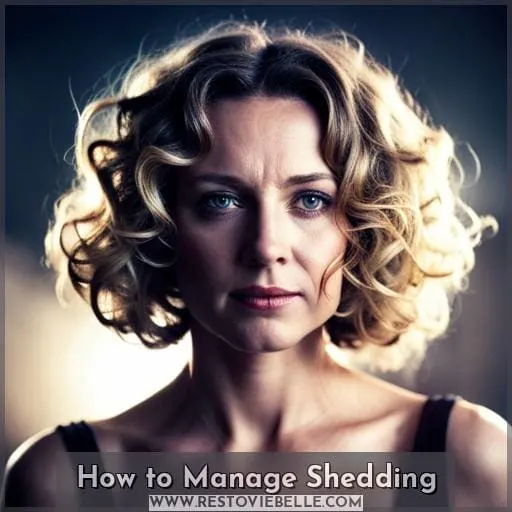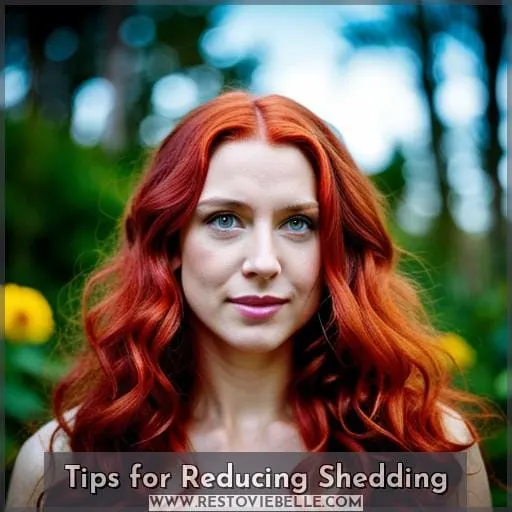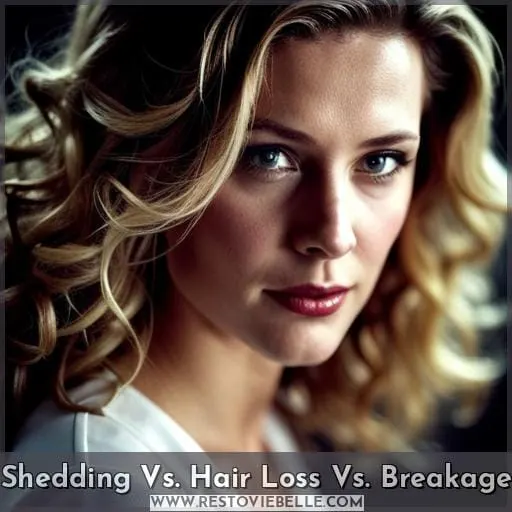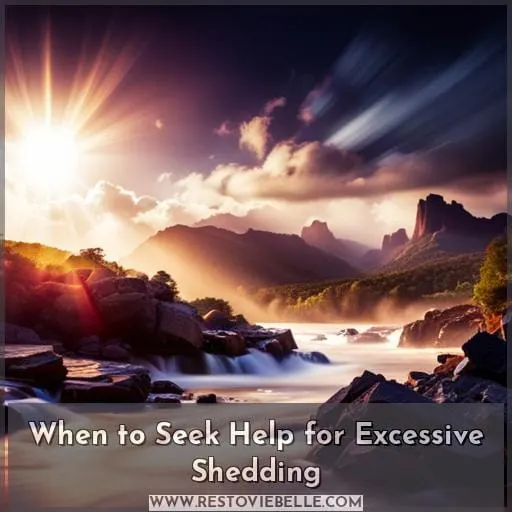This site is supported by our readers. We may earn a commission, at no cost to you, if you purchase through links.
 Worry no more, curly sister! Your hair is not falling out; it’s just shedding – a natural process we thick-maned ladies deal with more than others. But don’t panic, losing a few strands a day is normal. If you see clumps circling the drain, though, excess shedding could be the culprit.
Worry no more, curly sister! Your hair is not falling out; it’s just shedding – a natural process we thick-maned ladies deal with more than others. But don’t panic, losing a few strands a day is normal. If you see clumps circling the drain, though, excess shedding could be the culprit.
Stress, hormones, scalp buildup – so many things can cause extra shedding. The good news? You can get ahead of it by figuring out the cause and adjusting your haircare routine. With some TLC for your curls, you’ll have less shedding and get your hair back on a healthy growth track in no time.
Shedding is just a phase, not permanent hair loss. Take a deep breath and remember: your curls are a source of freedom and belonging.
Table Of Contents
Key Takeaways
- Shedding 50-100 strands per day is normal, but excessive shedding can be caused by inflammation and toxicity.
- Managing shedding involves gentle detangling, occasional clarifying, and moisturizing hair care.
- Seek professional help if losing more than 100 strands daily without explanation.
- Reduce shedding by supporting hair growth through nutrition, lowering stress and heat styling.
What is Hair Shedding?
You’re shocked when your curls suddenly start raining down in the shower. Shedding is a natural process where some hair follicles on your head enter a resting phase and the hair falls out. It’s especially common in those with curly hair since there are more hair follicles per square inch of the scalp.
On average, losing 50-100 strands per day is normal, but shedding can increase due to changes in seasons, stress levels, hormones, age, or the use of new products.
While you can’t completely prevent shedding, you can reduce excessive loss by managing stress through yoga and meditation, using curly hair products without harsh ingredients, regularly clarifying your scalp, and avoiding things that damage hair like excessive heat styling.
If you’re losing more than 100 strands per day without an identifiable cause, it’s best to see a dermatologist.
Is Shedding Normal for Curly Hair?
Seeing more strands come loose when detangling your coils is common. Curly hair has more follicles per square inch, so shedding often appears more dramatic. The curl pattern causes shed hairs to tangle within curls rather than falling away.
Curly hair’s tendency to be washed less frequently allows more shed hair to accumulate before detangling.
Shedding 50-100 strands daily is considered normal, but curly hair’s texture simply reveals the shedding more than straight hair. While alarming, seeing extra strands when washing or detangling curly hair is often natural shedding.
Focus on keeping hair moisturized, gently detangling, and treating hair delicately to minimize excess shedding. If excessive shedding persists without explanation, consult a trichologist to identify and address the cause.
What Causes Excessive Shedding?
Excessive shedding can have many possible causes. Stress, poor nutrition, and inflammation are three main factors that may result in higher than normal hair loss. Prolonged or severe stress can disrupt the hair growth cycle and lead to increased shedding.
Deficiencies in certain vitamins, minerals, and proteins may also trigger excessive hair fall. Chronic inflammation, from conditions like scalp infections, skin disorders, or autoimmune diseases, can negatively impact hair follicles and cause rapid shedding.
Other potential contributors include childbirth, major surgery, iron deficiency anemia, crash dieting, hypothyroidism, and drug side effects. Heredity and hormonal changes like menopause may also play a role for some. The reasons for increased shedding can be complex, so it is advisable to consult a dermatologist if unexplained hair loss persists.
They can help identify the underlying cause and recommend appropriate treatment options tailored to your specific situation.
Stress
The stress you’re dealing with is causing excessive shedding. Anxiety triggers our body’s fight-or-flight response, releasing cortisol. This hormone can prolong the resting phase, causing excess shedding. Try deep breathing, yoga, meditation—lowering cortisol levels.
Eliminate stressors when possible. Curl enhancing products with scalp-soothing ingredients reduce inflammation, managing stress-related hair loss.
Nutrient Deficiency
A jaded spirit looms when vital nutrients evade your follicles’ bloom.
- Deficiencies in key compounds for hair growth like vitamins A, B, C, D, iron, and zinc can exacerbate shedding.
- Prioritize antioxidant-rich foods like berries and green tea to resist oxidative stress and excessive shedding.
- Supplement your diet with biotin, saw palmetto, collagen peptides, and vitamin C for optimal hair health.
An imbalanced diet lacking in crucial nutrients for hair growth can contribute to increased shedding. Upgrading your nutritional intake through whole foods and targeted supplements provides the building blocks for strong, healthy hair and may help normalize shedding.
Focus on foods and supplements rich in vitamins, minerals, antioxidants, and compounds that support follicle health.
Inflammation
Your inflamed scalp needs soothing to minimize excessive shedding. Curly hair naturally tends toward inflammation. Daily stresses and tight styles increase sensitive scalp inflammation. That fiery environment hinders healthy anagen follicles and encourages excess shedding.
Soothe irritation with gentle scalp massage, relaxing activities, and anti-inflammatory products to encourage growth.
How to Manage Shedding
To manage hair shedding, regularly detangle curls after washing using a wide-tooth comb or fingertips. Clarify buildup occasionally with a detox wash and condition with moisture-replenishing ingredients.
Avoid excessive blow drying or overusing other heat appliances that weaken strands. Limiting heat damage while properly hydrating, cleansing, and gently detangling hair will help reduce and control shedding.
Detangling
To reduce shedding, you’ve got to detangle hair gently after washing. Detangling curly hair prevents excess shedding by removing knots and tangles. Use a wide-tooth comb or wet brush and start at the ends, working up towards the roots carefully.
Avoid ripping through knots to prevent breakage. Conditioner makes strands more slippery, so product will help with detangling. Finger detangle first, then use your tool gently in sections. Patience prevents damage when detangling, helping reduce shedding.
Clarifying and Conditioning
Choosing the right cleanser and conditioner for your curl type helps prevent dryness and damage that can lead to shedding. A clarifying shampoo reduces inflammation and excess shedding by removing product buildup.
Conditioning with ingredients like hyaluronic acid provides moisture and helps repair damage. Detangling is crucial after washing to prevent snags and excess shedding. Finding the optimal cleanser and conditioner routine tailored to your curls keeps your mane healthy and reduces shedding.
Reducing Heat Styling
Didn’t you know that blow-drying can weaken hair bonds and cause more strands to shed? Why not try air-drying instead to maintain your curls’ integrity.
- Restrict heated styling to special events or once weekly.
- Buy a silk pillowcase or bonnet to preserve overnight curls.
- Attempt no-heat techniques like braiding, twisting, or pin curling.
- Always apply a heat protectant before heat styling.
Lower heat settings or avoiding hot tools completely can really minimize damage and shedding.
Tips for Reducing Shedding
As we discussed, curly hair tends to shed more than other hair types. While some shedding’s normal, excessive shedding can be concerning.
- Be gentle when handling your curls. Avoid harsh brushing, tight hairstyles, and rough handling that can lead to hairs breaking off.
- Look for hair products made for curly hair that provide moisture and reduce frizz without being too heavy. Dry, brittle hair’s prone to tangling and breakage. Keep your curls properly hydrated.
- Get on a regular hair care schedule. Skipping washes allows shed hairs to tangle and makes detangling harder.
- Consider taking supplements that support hair growth like biotin, vitamin D, iron, and zinc.
Shedding can’t be eliminated entirely, but staying on top of moisture, regularly detangling, and avoiding damage can make a noticeable difference.
Shedding Vs. Hair Loss Vs. Breakage
You’re worried it’s gone forever when really it’s just taking a break. Understanding shedding vs hair loss vs breakage enables you to address your hair concerns properly.
Shedding is temporary hair falling out; it’s a natural part of the growth cycle. Hair loss is permanent hair not growing back; it can lead to bald spots.
50-100 hairs shed daily. Shedding is influenced by seasons and hormones. Hair loss is triggered by issues like inflammation and caused by toxicity and autoimmune disorders.
Shedding’s a normal process, but excessive shedding indicates an underlying issue. Hair loss means follicles are damaged and hair’s not regrowing. To care for curly hair prone to shedding, focus on scalp health, moisture, and minimizing damage through proper detangling, styling, and nutrition.
When to Seek Help for Excessive Shedding
You should see a dermatologist if you’re suddenly losing more than 100 hairs a day to determine the underlying cause, like Mary whose excess shedding was traced back to an iron deficiency.
Identify triggering factors like changing seasons, hormones, or stressful events.
Note any scalp irritation, flaking, or redness that could point to issues like dandruff or infection needing treatment.
Track the actual number of strands lost per day to quantify the shedding and note if it worsens.
Consider bloodwork to check for nutritional deficiencies or hormone imbalances contributing to shedding.
Discuss options like supplements, medicated shampoos, or laser treatments that may help reduce shedding.
Seeking professional guidance is key if excessive shedding persists without explanation. A dermatologist can pinpoint the reason through evaluation and testing, then offer solutions tailored to your specific situation.
Don’t resign yourself to ongoing hair loss; take action by making an appointment to address both the physical and emotional impact of unexplained shedding.
My Experience With Shedding as a Curly
As a curly, shedding’s been an annoying part of my hair care journey. I used to shed so much hair in the shower, it’d clog the drain. My hair felt thin and lacked density. Through trial and error, I’ve found techniques to reduce shedding.
Using a pre-shampoo oil or mask, detangling gently with my fingers, and styling upside down less often has made a noticeable difference. I incorporated stress-relieving habits like meditation, reduced heat styling, and focused on getting enough protein and vitamins.
While shedding still happens occasionally, it’s no longer excessive thanks to preventative measures. My curls have much better density and health these days. Though frustrating, being diligent with curly hair care has kept shedding manageable for me.
Conclusion
You’ve tackled your curly hair shedding, and now it’s time to wave goodbye. By bravely embracing the tangles and nourishing your curls, your hair has bounced back from the brink. So smile as you scrunch those spirals – your hair hurricane has calmed. Though curly hair may shed more than straight hair, you’ve weathered the storm.
Now flaunt those flyaways with pride, taking comfort knowing your ringlets rule once more.


